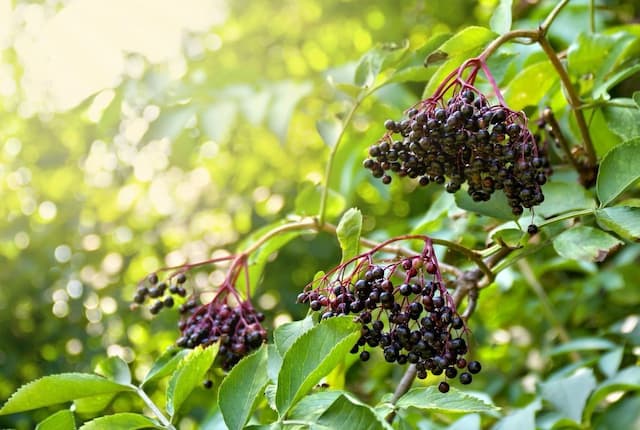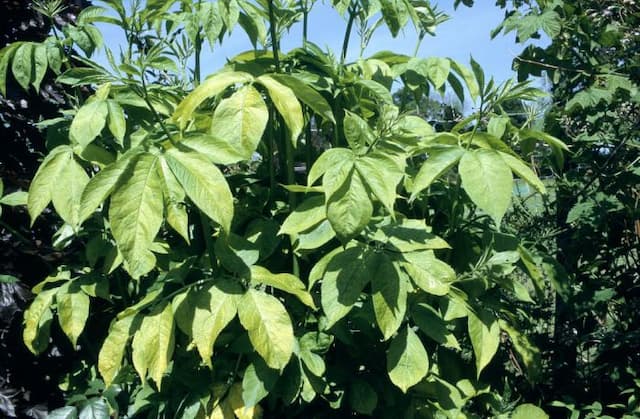Japanese Snowball Viburnum plicatum f. tomentosum 'Pink Beauty'

ABOUT
'Pink Beauty' is a type of doublefile viburnum known for its distinctive flowers and layered branching habit. The branches grow horizontally, creating a tiered appearance that is aesthetically pleasing throughout the year. In the spring, the plant boasts an abundance of showy, rounded flower clusters that start out as light pink buds. These buds open up to delicate, white lace-cap flowers that have a pink blush. As the plant matures through the flowering season, the pink shades can become more pronounced, offering a lovely contrast with the dark green, deeply veined leaves. The leaves themselves are sizable and have a textured, pleated appearance, hence the term "plicatum" in the plant's name, which refers to the pleated or folded nature of the foliage. When autumn arrives, the leaves may turn vibrant shades of red and burgundy, providing a striking display of fall color. After the flowering season, the plant can produce red berry-like fruits that eventually mature to a black color, attracting birds and other wildlife to the garden. Even in the absence of leaves during the winter, the strong horizontal lines of the branches offer a structural beauty to the landscape.
About this plant
 Names
NamesFamily
Adoxaceae
Synonyms
Japanese Snowball, Doublefile Viburnum, Japanese Snowball Bush, Pink Beauty Doublefile Viburnum
Common names
Viburnum plicatum f. tomentosum 'Pink Beauty'.
 Toxicity
ToxicityTo humans
Doublefile viburnum is not considered toxic to humans. Therefore, ingesting this plant typically does not pose a risk of poisoning or cause symptoms in humans. It's always prudent, however, to avoid eating ornamental plants as they are not intended for consumption and could cause gastrointestinal discomfort.
To pets
Doublefile viburnum is generally considered to be non-toxic to pets. It is not known to cause poisoning in domestic animals such as dogs and cats if they ingest parts of this plant. Despite its non-toxic nature, it is still advisable to prevent pets from eating ornamental plants to avoid any potential stomach upset.
 Characteristics
CharacteristicsLife cycle
Perennials
Foliage type
Deciduous
Color of leaves
Green
Flower color
Pink
Height
8-10 feet (2.4-3 meters)
Spread
6-8 feet (1.8-2.4 meters)
Plant type
Shrub
Hardiness zones
5
Native area
Japan China
Benefits
 General Benefits
General Benefits- Aesthetic appeal - The 'Pink Beauty' variety of Doublefile Viburnum, as it is commonly known, features beautiful light pink flowers that provide visual interest and aesthetic appeal to any garden or landscape.
- Seasonal interest - This plant offers a long season of beauty with attractive spring blooms, lush summer foliage, vibrant fall leaves, and sometimes bright red berries that add to its year-round interest.
- Habitat for wildlife - It can attract various forms of wildlife, such as butterflies and bees, which are drawn to its flowers for nectar, and birds, which may eat its berries.
- Low maintenance - Doublefile Viburnum is known for being a low maintenance plant, which does not require much attention once established, making it ideal for gardeners of all skill levels.
- Drought tolerance - Once established, this plant is relatively drought tolerant, requiring less water than many other ornamental plants, which can be beneficial in areas with water-use restrictions or for gardeners seeking to conserve water.
- Privacy screen - When planted in a row or group, Doublefile Viburnum can act as a natural privacy screen, helping to create a private space or block unsightly views with its dense foliage.
 Medical Properties
Medical PropertiesThis plant is not used for medical purposes.
 Air-purifying Qualities
Air-purifying QualitiesThis plant is not specifically known for air purifying qualities.
 Other Uses
Other Uses- Viburnum plicatum, commonly known as doublefile viburnum, can be used in the creation of natural dyes, leveraging various parts of the plant to produce a range of colors for textiles.
- Doublefile viburnum branches with their robust structure and attractive foliage can be included in floral arrangements to add a rustic or woodland aesthetic.
- With its dense growth habit, the doublefile viburnum can be trimmed into a natural privacy screen or hedge in landscaping designs, offering a living fence that changes with the seasons.
- The leaves of doublefile viburnum have been traditionally used in sachets or potpourri mixes for their texture and sometimes for their aromatic qualities when dried.
- Photographers and artists often use doublefile viburnum as a subject or backdrop in their work, capturing the intricate details of the blooms and the plant's form.
- Educational institutions can utilize doublefile viburnum plantings as a tool for teaching botany and ecology, demonstrating the life cycle and growth patterns of a deciduous shrub.
- The layered branching pattern of doublefile viburnum makes it an ideal candidate for bonsai cultivation, presenting a challenge for enthusiasts to miniaturize its naturally horizontal tiers.
- Bird enthusiasts might plant doublefile viburnum as an attractant, as its fruit provides a food source for many bird species, thus encouraging avian biodiversity in the garden.
- In landscape photography, the plant is used as a natural framing element due to its horizontal branching, enhancing the composition and depth of field in outdoor scenes.
- Culinary artists sometimes use the blooms of the doublefile viburnum as an ornamental edible garnish for delicate desserts and specialty dishes, though consumption of other plant parts is not recommended.
Interesting Facts
 Feng Shui
Feng ShuiThe plant Doublefile Viburnum is not used in Feng Shui practice.
 Zodiac Sign Compitability
Zodiac Sign CompitabilityThe Doublefile Viburnum is not used in astrology practice.
 Plant Symbolism
Plant Symbolism- Renewal: The 'Pink Beauty' variety of Japanese Snowball (Viburnum plicatum f. tomentosum) blooms in the spring, representing the idea of rebirth and new beginnings as it coincides with the awakening of nature after winter.
- Purity: The Japanese Snowball often symbolizes purity due to its delicate and often white or pale pink blossoms, which can evoke a sense of innocence and cleanliness.
- Beauty: With 'Pink Beauty' specifically referring to its charming pink bloom, it's commonly associated with outer and inner beauty, as well as elegance and grace.
- Eternity: The rounded shape of the Japanese Snowball flowers can symbolize eternity or infinity, representing the cyclical nature of life and the enduring spirit.
 Water
WaterJapanese Snowball, 'Pink Beauty,' thrives when watered deeply, allowing the soil to become moist but not soggy. During the first growing season, establish a regular watering schedule by watering the plant once a week with approximately 1-2 gallons of water to encourage a deep root system. As the plant becomes established, reduce the frequency to every two to three weeks, depending on weather conditions and soil type. Overwatering can lead to root rot, so ensure the plant is not sitting in waterlogged soil. During extended periods of drought or extreme heat, increase watering frequency to prevent stress.
 Light
LightJapanese Snowball, 'Pink Beauty,' prefers partial to full sunlight. The ideal spot for planting this shrub is an area where it can receive at least 4-6 hours of direct sun daily, with some dappled afternoon shade to protect it from the harsh late-day sun. Too much shade will reduce the number of flowers and can lead to leggier growth.
 Temperature
TemperatureJapanese Snowball 'Pink Beauty' can tolerate a range of temperatures but grows best in moderate conditions. It can survive minimum winter temperatures down to around -10 to -20°F without significant damage. The ideal temperature range for optimal growth is between 60°F and 80°F. Extreme heat or cold may affect blooming and overall health, so it's best to plant it in a location that avoids temperature extremes.
 Pruning
PruningPruning Japanese Snowball 'Pink Beauty' helps maintain its shape, encourages healthy growth, and improves air circulation. Prune immediately after the shrub has finished flowering, usually in late spring or early summer, to remove any dead or crossing branches and to shape the plant. Thinning out older stems every few years encourages rejuvenation. Avoid heavy pruning in late summer or fall, as this can reduce the next year's blooms.
 Cleaning
CleaningAs needed
 Soil
SoilDoublefile Viburnum thrives best in moist, well-drained soil that is rich in organic matter. A blend of loamy garden soil, peat moss, and perlite would make for an ideal soil mix. Aim to maintain a soil pH of 5.5 to 6.5 for optimal growth and health of the Doublefile Viburnum.
 Repotting
RepottingDoublefile Viburnum should be replanted or repotted every 3 to 5 years to ensure it has enough room for root growth. It’s generally done in the late winter or early spring before the onset of new growth.
 Humidity & Misting
Humidity & MistingDoublefile Viburnum prefers average humidity levels found in outdoor environments. It does not require special humidity conditions and tolerates the seasonal changes well.
 Suitable locations
Suitable locationsIndoor
Provide bright light and space for Doublefile Viburnum.
Outdoor
Choose sun to partial shade; ensure soil drains well.
Hardiness zone
5-8 USDA
 Life cycle
Life cycleThe life cycle of the Viburnum plicatum f. tomentosum 'Pink Beauty', commonly known as Doublefile Viburnum, begins with germination, where the stratified seed sprouts in moist, well-drained soil in spring. Following germination, the seedling stage sees the growth of a young plant that gradually develops a root system and foliage. As the plant enters the vegetative growth stage, it produces lush green leaves along horizontally tiered branches, growing in width and height. This leads to the flowering stage, typically in late spring, where 'Pink Beauty' showcases its pink to white lace-cap flowers, attracting various pollinators. After pollination, the plant enters the fruiting stage, during which red to black drupes form, providing food for wildlife. Ultimately, the plant reaches maturity, repeating the blooming and fruiting cycle annually, while potentially living several decades with proper care.
 Propogation
PropogationPropogation time
Spring-Early Summer
The Japanese Snowball 'Pink Beauty', a cultivar of Viburnum plicatum f. tomentosum, is commonly propagated through softwood cuttings taken in late spring or early summer when new growth is still tender. To do this, select a healthy stem with new growth, and cut a 4 to 6-inch (10 to 15 cm) piece just below a node, where leaves emerge. Remove the leaves from the lower half of the cutting and dip the cut end into rooting hormone to encourage root development. Plant the cutting in a well-draining potting mix, water thoroughly, and cover with a plastic bag to maintain humidity. Place the cutting in indirect light and keep the soil consistently moist but not waterlogged. Roots typically develop within 4 to 8 weeks, at which point the cutting can be gradually acclimatized to less humid conditions before eventually being moved to a permanent location.



![Elder [Black Tower]](/_next/image?url=https%3A%2F%2Fplants-admin.emdemapps.com%2Fimages%2Fplants%2F%2Fimages%2F604b5cad99578.png&w=640&q=75)





